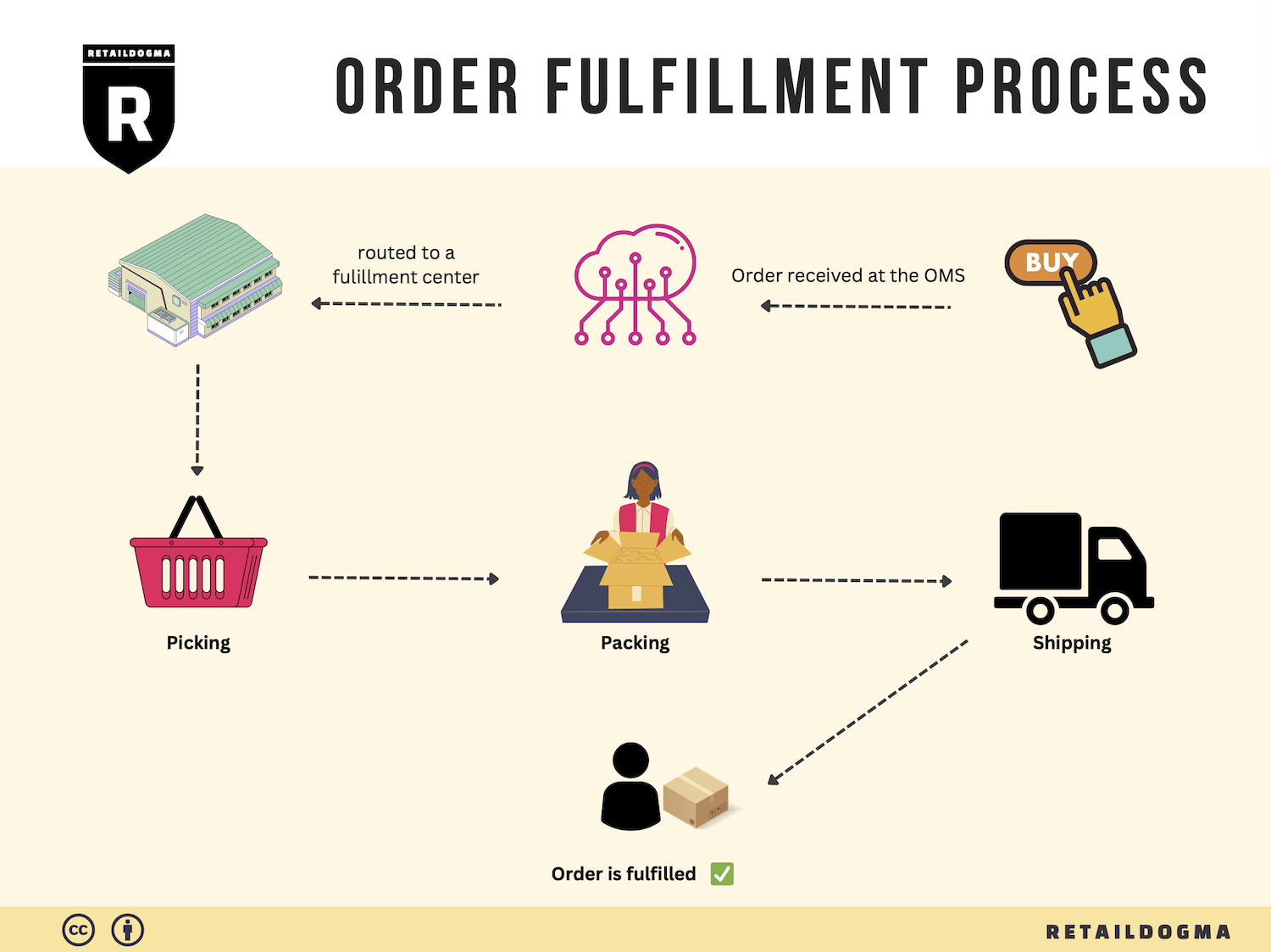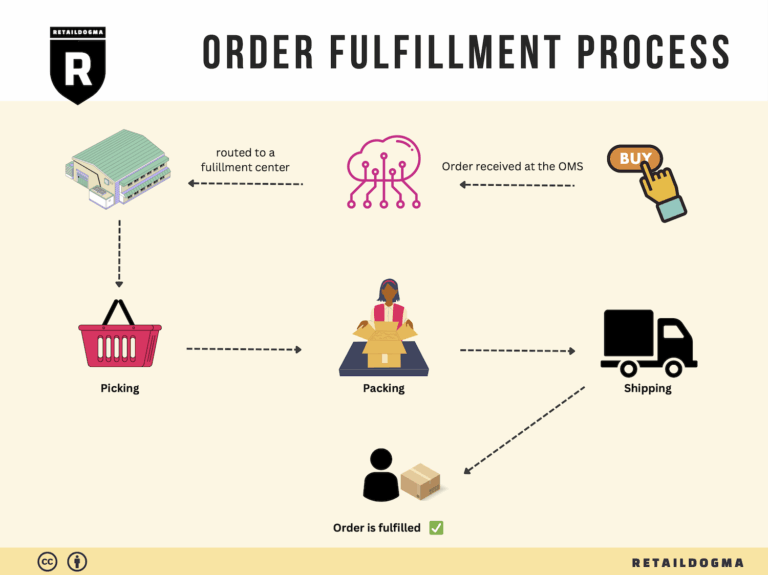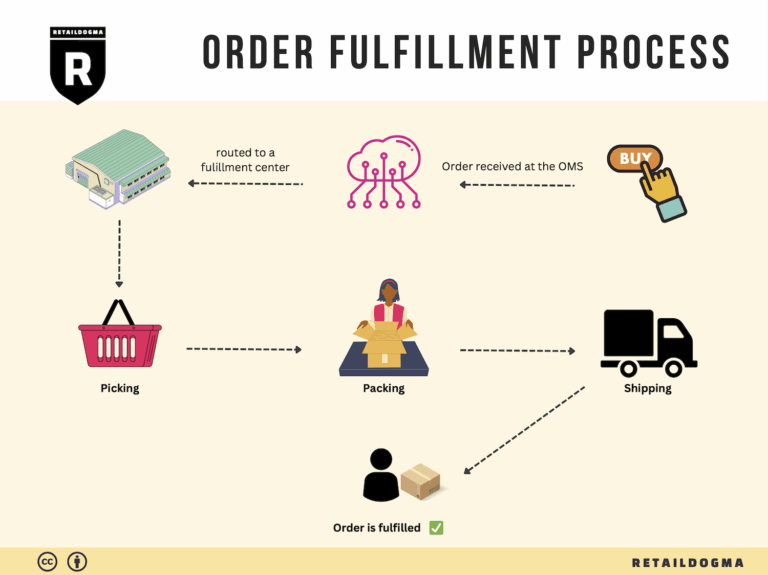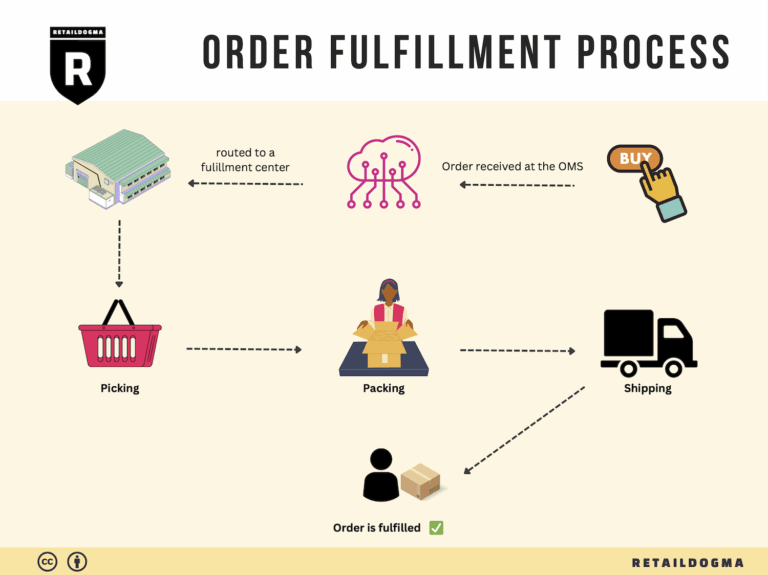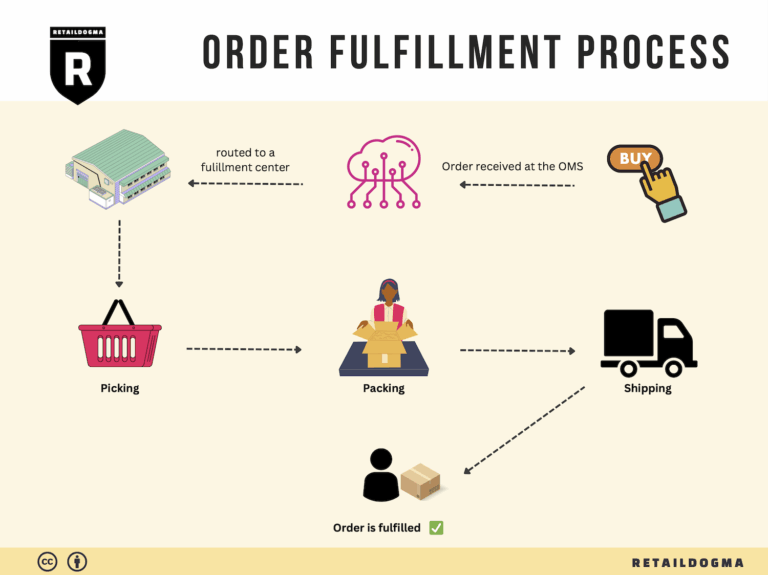How Order Fulfillment Works: A Step-by-Step Guide for Businesses
What is E-commerce Fulfillment? An Introduction for Growing Businesses
Understanding the Challenges of E-commerce Fulfillment
As an e-commerce business owner, you likely face the daunting task of managing the logistics of packing and shipping orders. The excitement of growth can quickly turn into overwhelm when you find yourself buried under boxes, shipping labels, and customer inquiries. The process of getting a product into the hands of a customer—known as fulfillment—can become a bottleneck that stifles your ability to scale.
Fulfillment, at its core, is the entire process of receiving, processing, and delivering an order to the customer. It encompasses everything from inventory management to shipping logistics. For growing businesses, navigating this landscape is crucial for maintaining customer satisfaction and ensuring operational efficiency.
What This Guide Will Cover
In this guide, we will explore the various models of e-commerce fulfillment that can help streamline your operations. You will learn about:
-
Fulfillment Models: We will discuss different fulfillment models such as Third-Party Logistics (3PL) and Fulfillment by Amazon (FBA). Each model has its advantages and can cater to specific business needs, allowing you to choose the best fit for your operation.
-
Core Services: We’ll delve into the core services provided by fulfillment partners, including inventory management, order picking, packing, shipping, and returns processing. Understanding these services will help you identify what you truly need from a fulfillment partner.
-
Choosing a Partner: Selecting the right fulfillment partner is critical. We will cover the key factors to consider, such as location, technology integration, and customer service capabilities, ensuring you make an informed choice that aligns with your business goals.
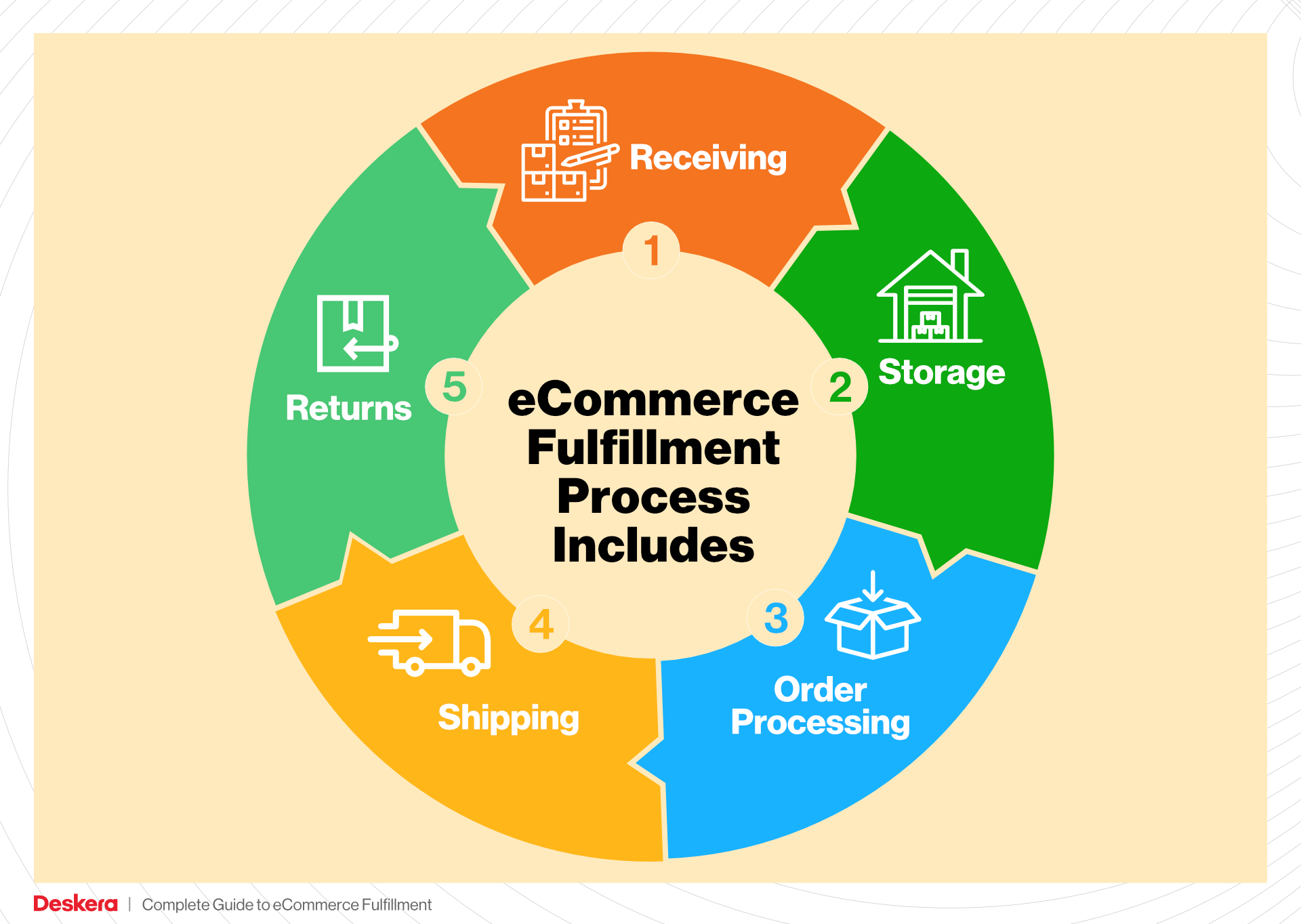
-
Pricing Structures: Finally, we will break down the pricing structures commonly associated with fulfillment services. Knowing what to expect in terms of costs can help you budget effectively and avoid surprises down the line.
Empowering Your Logistics Decisions
The goal of this guide is to empower you, the business owner or operations manager, to make informed decisions about your logistics strategy. By understanding the intricacies of e-commerce fulfillment, you can alleviate the stress of order processing and focus on what matters most: growing your business. With the right knowledge and partner, you can enhance your efficiency, improve customer satisfaction, and scale your operations seamlessly.
What You’ll Learn In This Guide
- What is E-commerce Fulfillment? An Introduction for Growing Businesses
- The Order Fulfillment Process: From ‘Buy’ Button to Customer’s Door
- Comparing Fulfillment Models: In-House vs. 3PL vs. Dropshipping
- A Deep Dive into Amazon FBA: Pros, Cons, and Who It’s For
- Core Services Offered by Fulfillment Centers
- How to Choose a Fulfillment Partner: A 6-Point Checklist
- Understanding Fulfillment Pricing: A Breakdown of Common Fees
- Frequently Asked Questions (FAQs) about Fulfillment
- Conclusion: Is Outsourcing Fulfillment the Right Move for Your Business?
- Important Disclaimer
The Order Fulfillment Process: From ‘Buy’ Button to Customer’s Door
1. Receiving Inventory
The first step in the order fulfillment process is receiving inventory. When products arrive at the fulfillment center, they are unloaded from trucks or containers and checked against the shipping documents to ensure accuracy. This step involves scanning each item using a barcode scanner, which links the product to its unique Stock Keeping Unit (SKU) in the inventory management system. The importance of this step lies in its role in maintaining accurate inventory levels and preventing stock discrepancies.
Proper receiving processes help to identify any damaged or incorrect items right away, allowing for timely resolutions. Efficient inventory receiving is critical because it sets the stage for all subsequent steps in the fulfillment process. If items are not received properly, it can lead to delays and errors downstream, affecting customer satisfaction and operational efficiency.
2. Warehouse Storage
Once the inventory has been received and verified, the next step is warehouse storage. This involves stowing items in designated areas within the fulfillment center. Effective storage is achieved through systematic organization, often categorized by product type, size, or sales velocity. This organization is facilitated by an advanced Warehouse Management System (WMS) that tracks where each item is stored.
The significance of this step cannot be overstated; efficient warehouse storage maximizes space and minimizes the time it takes to locate items during order picking. A well-structured storage system allows for quick access to high-demand products, ensuring that they can be picked swiftly when orders come in. This ultimately contributes to faster order fulfillment times and enhances the overall efficiency of the supply chain.
3. Order Picking
After an order is placed by a customer, the next step is order picking. This process involves generating pick lists, which detail the items that need to be collected from storage to fulfill the order. In modern fulfillment centers, including those operated by Amazon, technology plays a pivotal role. For instance, automated systems may bring storage pods to pick stations, where associates or robots retrieve the items.
Order picking is vital as it directly impacts the speed and accuracy of order fulfillment. Errors during this phase can lead to incorrect shipments, resulting in customer dissatisfaction and increased return rates. Thus, implementing efficient picking methods, whether manual or automated, is essential for maintaining high service levels and reducing operational costs.
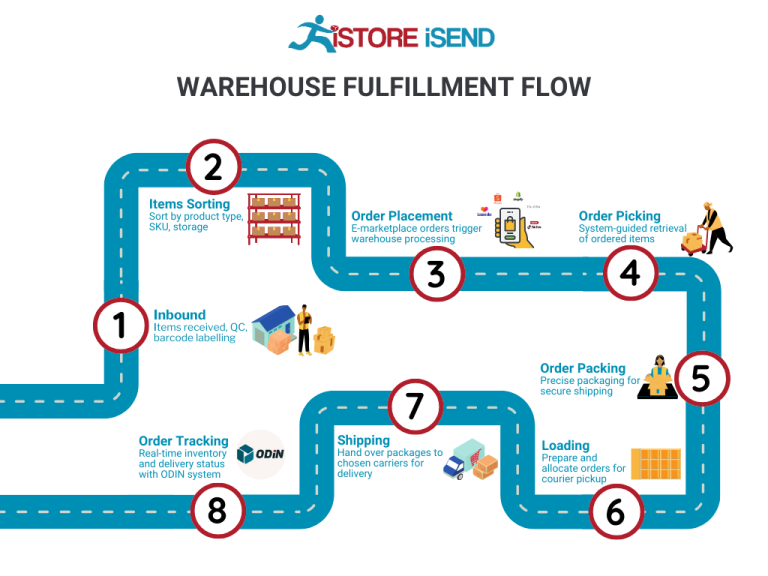
4. Order Packing
Once items are picked, they move to the order packing stage. During this step, items are scanned for accuracy and prepared for shipment. The packing process often includes selecting the appropriate packaging materials to protect the items during transit. Advanced fulfillment centers utilize systems that recommend box sizes based on the items being shipped, optimizing material usage and reducing waste.
The packing stage is crucial because it ensures that products are securely packaged to prevent damage during delivery. Proper packing also facilitates efficient shipping, as accurately packed items can streamline the sorting and loading processes. Additionally, a well-executed packing operation can enhance the customer experience, as neatly packaged orders are often associated with higher quality service.
5. Shipping & Delivery
The final step in the fulfillment process is shipping and delivery. Once orders are packed, they are labeled and sorted based on their destination and required delivery speed. Fulfillment centers like Amazon employ sophisticated scanning and sorting technologies to ensure packages are dispatched efficiently. Depending on the chosen shipping method, packages may be sent via Amazon’s own delivery fleet or third-party carriers.
This step is critical as it directly affects the customer’s experience and satisfaction. Timely delivery is a key factor in customer retention and loyalty. Fulfillment centers must leverage various transportation methods—such as trucks, vans, and even drones—to meet customer expectations for fast delivery. By optimizing shipping routes and methods, businesses can reduce costs and improve delivery times, ultimately enhancing the overall effectiveness of their order fulfillment process.
In conclusion, understanding and optimizing each of these five steps—receiving inventory, warehouse storage, order picking, order packing, and shipping & delivery—can significantly enhance the efficiency and effectiveness of your order fulfillment process. By focusing on these areas, e-commerce businesses can scale their operations and improve customer satisfaction, leading to sustainable growth in the competitive online marketplace.
Comparing Fulfillment Models: In-House vs. 3PL vs. Dropshipping
Fulfillment Model Comparison Table
| Model | Who Handles Inventory | Best For (Business Stage) | Key Advantage | Key Disadvantage |
|---|---|---|---|---|
| In-House Fulfillment | The business itself | Established businesses | Greater control over inventory and operations | High overhead costs and resource intensive |
| Third-Party Logistics (3PL) | A third-party logistics provider | Growing businesses | Scalability and reduced operational burden | Less control over inventory and processes |
| Dropshipping | Supplier/vendor | Startups and small businesses | Low upfront investment and no inventory risk | Lower profit margins and reliance on suppliers |
In-House Fulfillment
In-house fulfillment refers to the process where a business manages all aspects of order processing, inventory storage, packing, and shipping within its own facilities. This model is typically best suited for established businesses that have the resources and infrastructure to handle logistics effectively. The key advantage of in-house fulfillment is the level of control it provides over inventory management, order accuracy, and customer service. Businesses can implement customized processes that align closely with their brand values and customer expectations. However, this model comes with significant disadvantages, including high overhead costs associated with warehousing, staffing, and technology investments. Additionally, managing logistics in-house can be resource-intensive, diverting attention from core business activities such as marketing and product development.
Third-Party Logistics (3PL)
Third-party logistics (3PL) involves outsourcing the logistics operations to a specialized provider that handles inventory management, warehousing, and shipping on behalf of the business. This model is ideal for growing businesses that want to scale operations without the burden of managing logistics themselves. The primary advantage of using a 3PL provider is scalability; businesses can easily adjust their storage space and shipping capabilities based on fluctuating demand without the need for significant capital investment. Additionally, 3PL providers often have advanced logistics technology and expertise that can enhance operational efficiency. However, a notable disadvantage is the reduced control over inventory and fulfillment processes. Businesses must rely on their 3PL partner to maintain quality and meet service standards, which can sometimes lead to misalignment with customer expectations.
Dropshipping
Dropshipping is a fulfillment model where the retailer does not keep goods in stock but instead transfers customer orders and shipment details directly to a supplier or manufacturer, who then ships the products directly to the customer. This model is particularly well-suited for startups and small businesses that may lack the capital or resources to invest in inventory. The key advantage of dropshipping is the low upfront investment; businesses only purchase inventory after a sale has been made, eliminating the risk of unsold stock. Moreover, it allows entrepreneurs to offer a wide range of products without the need for physical storage space. However, dropshipping also has significant drawbacks, including lower profit margins due to reliance on supplier pricing and the potential for longer shipping times, which can affect customer satisfaction. Furthermore, businesses have limited control over product quality and fulfillment speed, making it crucial to partner with reliable suppliers to mitigate these risks.
In summary, each fulfillment model presents its own unique set of advantages and challenges. Businesses should carefully evaluate their specific needs, resources, and growth plans when choosing the right fulfillment strategy to effectively scale operations and meet customer demands.
A Deep Dive into Amazon FBA: Pros, Cons, and Who It’s For
Understanding Fulfillment by Amazon (FBA)
Fulfillment by Amazon (FBA) is a service offered by Amazon that allows sellers to store their products in Amazon’s fulfillment centers. This service takes care of storage, packaging, and shipping, enabling sellers to focus on other aspects of their business. When a customer orders a product, Amazon handles the entire fulfillment process, from picking and packing to shipping and customer service. This streamlined approach allows sellers to leverage Amazon’s vast logistics network and customer base, making it an attractive option for e-commerce businesses.
How FBA Works
-
Inventory Preparation: Sellers prepare their products according to Amazon’s guidelines and ship them to one or more of Amazon’s fulfillment centers. Each product must be labeled correctly, and packaging must meet specific standards.
-
Storage: Once the products arrive at the fulfillment center, they are stored until sold. Amazon uses advanced inventory management systems to track stock levels and product locations.
-
Order Processing: When a customer places an order for a product fulfilled by Amazon, the system automatically processes the order. The fulfillment center picks the product from storage, packs it, and ships it directly to the customer.
-
Shipping: Amazon offers various shipping options, including Prime shipping, which allows for expedited delivery. This ensures that customers receive their orders quickly, often within two days.
-
Customer Service: Amazon also handles customer inquiries and returns for FBA orders. This service provides peace of mind to sellers, knowing that customer issues are managed by a trusted platform.
Pros of Using FBA
-
Prime Eligibility: Products fulfilled by Amazon are eligible for Amazon Prime, which can significantly boost sales. Prime members often prefer items with this designation due to the benefits of fast, free shipping.
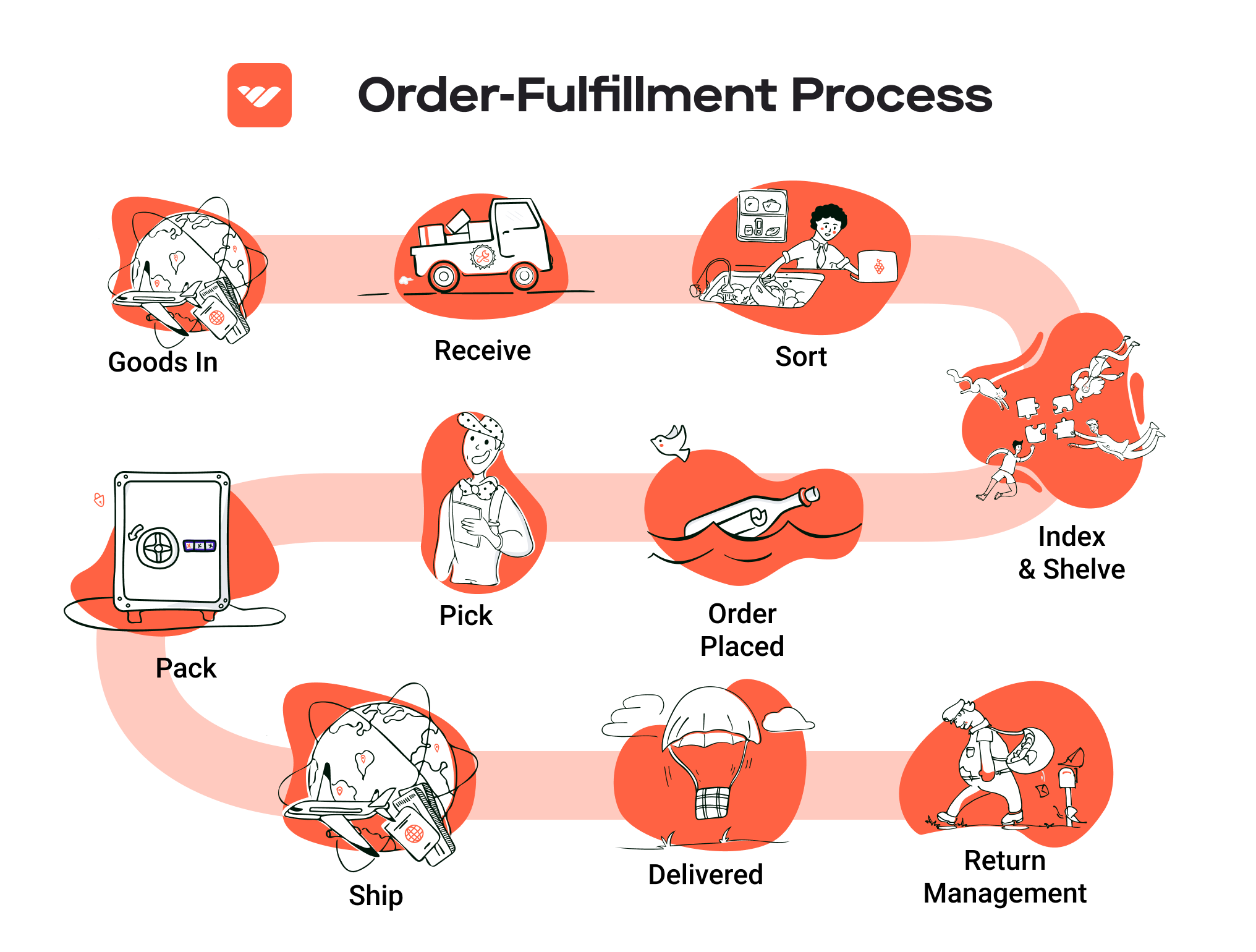
-
Customer Trust: Leveraging Amazon’s brand reputation can increase customer confidence in purchasing your products. Buyers are more likely to trust products fulfilled by Amazon, knowing they will receive reliable service.
-
Multi-Channel Fulfillment: FBA allows sellers to fulfill orders from multiple sales channels, not just Amazon. This means you can sell on your website or other marketplaces while still using Amazon’s fulfillment services.
-
Scalability: FBA enables businesses to scale quickly without the need to invest heavily in logistics and warehousing. As sales grow, Amazon’s infrastructure can handle increased demand seamlessly.
-
Time Savings: By outsourcing fulfillment to Amazon, sellers can save time on packing, shipping, and customer service, allowing them to focus on marketing and product development.
Cons of Using FBA
-
High Fees: FBA comes with various fees, including storage fees for inventory stored in fulfillment centers and fulfillment fees for each order processed. These costs can add up, especially for low-margin products.
-
Strict Inventory Rules: Amazon has stringent guidelines regarding inventory management, including restrictions on the types of products that can be sold and how they must be packaged. Non-compliance can lead to additional fees or account suspension.
-
Commingling Risks: Amazon commingles inventory from different sellers, meaning that products from various sellers may be stored together. This poses a risk if customers receive products that do not match their orders, which can lead to negative reviews and impact seller ratings.
-
Limited Control: Sellers have limited control over the fulfillment process. Any issues that arise during shipping or handling are managed by Amazon, which can sometimes lead to dissatisfaction if the service does not meet expectations.
-
Inventory Management Challenges: Sellers must continuously monitor their inventory levels to avoid stockouts or excess storage fees. Mismanagement can lead to lost sales or increased costs.
Who is FBA Best For?
Fulfillment by Amazon is ideal for a variety of sellers, particularly those looking to scale their operations without the complexities of managing logistics. Here are some profiles of businesses that can benefit most from FBA:
-
Small to Medium-Sized E-commerce Businesses: Entrepreneurs who want to focus on growing their business without the hassle of fulfillment logistics.
-
Sellers with High Sales Volume: Businesses that have a significant number of orders can benefit from the efficiency and speed of Amazon’s fulfillment network.
-
New Sellers: Individuals entering the e-commerce space can leverage FBA to quickly establish credibility and gain access to Prime customers.
-
Businesses with Seasonal Products: Companies that experience fluctuations in sales can use FBA to manage inventory without committing to long-term warehousing costs.
-
Multi-Channel Sellers: Brands selling on various platforms can take advantage of Amazon’s fulfillment services while still reaching customers outside of Amazon.
In summary, Fulfillment by Amazon offers a powerful solution for e-commerce businesses looking to streamline their logistics and enhance customer satisfaction. While there are costs and risks involved, the advantages often outweigh the downsides, making it a viable option for many sellers aiming to scale their operations effectively.
Core Services Offered by Fulfillment Centers
Inventory Management & Warehousing
Inventory management and warehousing are foundational services provided by fulfillment centers. This process begins with the reception of goods into the fulfillment center, where products are logged and categorized. Advanced technology, such as barcode scanning and inventory management software, is employed to track stock levels, monitor product locations, and manage reordering processes.
For e-commerce businesses, effective inventory management translates to several key benefits:
-
Optimized Stock Levels: Maintaining the right amount of inventory helps prevent stockouts and overstock situations. Fulfillment centers use real-time data to inform sellers when to reorder products, ensuring that they meet customer demand without tying up excessive capital in unsold stock.
-
Efficient Space Utilization: By leveraging a fulfillment center’s expertise in warehousing, businesses can maximize their storage space and reduce costs associated with maintaining their own facilities. This is particularly advantageous for small to mid-sized e-commerce operations that may not have the resources to manage a warehouse.
-
Scalability: As an e-commerce business grows, so does its inventory. Fulfillment centers provide scalable solutions that allow businesses to expand their inventory without the need for significant investment in infrastructure.
Pick and Pack Services
Once an order is placed, the next critical service offered by fulfillment centers is pick and pack. This process involves retrieving the purchased items from their storage locations, packing them securely for shipment, and preparing them for delivery.
The benefits of efficient pick and pack services include:
-
Speed and Accuracy: Fulfillment centers utilize automated systems and trained staff to ensure that orders are picked quickly and accurately. This reduces the likelihood of errors, enhancing customer satisfaction and trust in the brand.
-
Cost Efficiency: By outsourcing pick and pack services, e-commerce businesses can reduce labor costs associated with hiring and training their own staff. Fulfillment centers can often operate more efficiently due to their specialized processes and economies of scale.
-
Custom Packaging Options: Many fulfillment centers offer customizable packing solutions, allowing businesses to enhance their brand presence through branded packaging, which can lead to improved customer loyalty and repeat purchases.
Kitting and Assembly
Kitting and assembly is another valuable service that fulfillment centers provide, particularly for businesses that sell products that require bundling or assembly before shipping. This might include items like subscription boxes, promotional kits, or products that need to be packaged together for sale.
The advantages of kitting and assembly include:
-
Streamlined Operations: By allowing fulfillment centers to handle the assembly of products, e-commerce businesses can streamline their operations and focus on core activities such as marketing and sales. This reduces the complexity of managing multiple products and enhances overall operational efficiency.
-
Enhanced Product Offerings: Kitting enables businesses to offer unique product bundles that may attract more customers and increase average order values. A well-assembled kit can provide added value to customers, making it more appealing than purchasing items individually.
-
Quality Control: Fulfillment centers often have established quality control processes in place, ensuring that assembled kits meet customer expectations and reducing the likelihood of returns due to assembly errors.
Returns Management (Reverse Logistics)
Returns management, or reverse logistics, is a critical service that fulfillment centers provide to help e-commerce businesses handle product returns efficiently. This involves processing returned items, restocking them if they are in sellable condition, or handling them according to the business’s return policy.
The benefits of effective returns management include:
-
Customer Satisfaction: A streamlined returns process enhances the customer experience. When customers know that returns are easy and hassle-free, they are more likely to make a purchase. This can lead to increased customer loyalty and positive reviews.
-
Data Insights: Fulfillment centers can provide valuable insights into return trends, helping businesses understand why products are being returned and allowing them to make informed decisions about product quality, pricing, or marketing strategies.
-
Cost Savings: Efficient returns management minimizes costs associated with processing returns, including shipping and handling. By optimizing this process, e-commerce businesses can reduce their overall operational costs and improve profitability.
Conclusion
Utilizing fulfillment centers for core services such as inventory management, pick and pack, kitting and assembly, and returns management allows e-commerce businesses to streamline operations, enhance customer satisfaction, and ultimately scale their operations effectively. By leveraging these specialized services, businesses can focus on growth and innovation, leaving the complexities of logistics to the experts.
How to Choose a Fulfillment Partner: A 6-Point Checklist
Location & Warehouse Network
Choosing a fulfillment partner with strategically located warehouses is crucial for ensuring timely deliveries and minimizing shipping costs. The proximity of fulfillment centers to your customer base can significantly impact delivery times, especially for e-commerce businesses competing on speed.
Questions to Ask:
– What is the geographic coverage of your warehouse network?
– How many fulfillment centers do you operate, and where are they located?
– Can you provide information on the average shipping times to key regions?
– Do you have fulfillment centers near major metropolitan areas?
Technology & Integrations
In today’s digital landscape, the technology used by your fulfillment partner can greatly influence your operational efficiency. A good 3PL should offer robust technology solutions that integrate seamlessly with your existing e-commerce platforms, inventory management systems, and shipping tools.
Questions to Ask:
– What software do you use for inventory management and order processing?
– Are your systems compatible with major e-commerce platforms (e.g., Shopify, Amazon, WooCommerce)?
– Do you offer real-time tracking and reporting capabilities?
– How often do you update your technology, and what are your plans for future enhancements?
Specializations (e.g., cold storage, oversized items)
Depending on the nature of your products, your fulfillment partner may need to have specific capabilities. If you sell perishable goods, for instance, you’ll need a partner with cold storage facilities. Similarly, if you deal in oversized items, ensure that your partner can accommodate those needs.
Questions to Ask:
– Do you have specialized facilities for my product type (e.g., cold storage, hazardous materials)?
– What is your experience with handling products similar to mine?
– How do you ensure compliance with industry regulations for specialized items?
– Can you provide examples of how you’ve successfully managed unique fulfillment challenges?
Scalability & Capacity
As your business grows, your fulfillment needs will likely change. Selecting a partner that can scale operations with your growth is essential to maintaining efficiency and customer satisfaction. A fulfillment partner should be able to handle seasonal spikes and long-term growth without sacrificing service quality.
Questions to Ask:
– How do you manage fluctuations in order volume during peak seasons?
– What is your maximum capacity for storage and order fulfillment?
– Can you provide case studies or examples of how you’ve scaled with other clients?
– What contingency plans do you have in place for unexpected surges in demand?
Pricing and Contracts
Understanding the pricing structure of your fulfillment partner is vital for maintaining healthy profit margins. Look for transparency in pricing and ensure that you understand all potential costs, including storage fees, picking and packing fees, and shipping costs.
Questions to Ask:
– What is your pricing model (e.g., per order, per item, monthly storage fees)?
– Are there any hidden fees I should be aware of?
– What is the minimum contract length, and are there options for flexibility?
– How do you handle price increases, and will I be notified in advance?
Customer Support & Reviews
The level of customer support offered by your fulfillment partner can greatly affect your business operations. Quick and responsive support is essential for resolving issues that may arise during the fulfillment process. Additionally, researching customer reviews can provide valuable insights into the partner’s reliability and service quality.
Questions to Ask:
– What customer support channels do you offer (e.g., phone, email, live chat)?
– What are your average response times for support inquiries?
– Can you provide references from current or past clients?
– How do you handle service disruptions, and what is your process for communication during those times?
Conclusion
Selecting the right fulfillment partner is a critical decision for any e-commerce business looking to scale. By carefully evaluating each of these six key areas—Location & Warehouse Network, Technology & Integrations, Specializations, Scalability & Capacity, Pricing and Contracts, and Customer Support & Reviews—you can make an informed choice that aligns with your business goals. Take the time to ask the right questions and gather the necessary information to ensure your partnership will contribute to your success in the competitive e-commerce landscape.
Understanding Fulfillment Pricing: A Breakdown of Common Fees
Initial Setup Fees
When starting with an Amazon Fulfillment Center, particularly under the Fulfillment by Amazon (FBA) program, businesses often encounter initial setup fees. These fees are typically charged for establishing your seller account and integrating your inventory with Amazon’s systems. The costs may vary based on the complexity of your operation, the number of SKUs you plan to manage, and the level of support needed for onboarding.
For instance, if you’re utilizing specialized services or require additional training, the setup fees could increase. It’s essential to clarify what services are included in the setup fee, such as training sessions or account management assistance, to avoid any unexpected costs.
Receiving Fees
Receiving fees are charged when your inventory arrives at the fulfillment center. This fee covers the labor and resources required to unload, inspect, and store your products. Generally, these fees are calculated based on the weight and dimensions of the items being received.
For example, if you send a shipment consisting of large, bulky items, you may incur higher receiving fees compared to smaller, lightweight products. Amazon typically charges a per-unit fee for each item received, so it’s crucial to factor in the size and volume of your inventory when budgeting for these costs.
Storage Fees (per pallet/bin)
Storage fees are incurred for the space your inventory occupies within the fulfillment center. Amazon typically charges these fees monthly and they can vary based on the season. For instance, storage fees may be higher during peak seasons, such as the holiday shopping period, when demand for storage capacity increases.
These fees are generally calculated on a per-pallet or per-bin basis, depending on how your products are stored. For example, if you have bulky items that take up more space, your storage fees will reflect that increased volume. Understanding the layout and storage options within the fulfillment center can help you optimize your inventory and potentially reduce storage costs.
Pick & Pack Fees (per item/order)
Pick and pack fees are charged for the labor involved in selecting items from the shelves and packing them for shipment. This fee is usually calculated on a per-item or per-order basis. The more items in an order, the higher the pick and pack fee will be.
For instance, if a customer orders multiple items, each item incurs a pick fee, and the order will also have a separate pack fee. These fees can vary depending on the complexity of the items being picked. Fragile or oversized items may incur additional handling charges. Understanding the nature of your products can help you predict these costs accurately.
Shipping Fees
Shipping fees are one of the most critical components of fulfillment pricing, as they cover the cost of delivering your products to customers. These fees are determined by several factors, including the shipping method selected, the destination of the shipment, and the weight and dimensions of the package.
Amazon offers various shipping options, from standard to expedited services, and costs will vary accordingly. It’s important to note that while Amazon has negotiated rates with shipping carriers, these costs can fluctuate based on fuel prices and other market variables. To manage shipping costs effectively, consider optimizing your product sizes and weights, and evaluate the shipping methods that align with your delivery speed requirements.
Tips for Getting an Accurate Quote
To obtain an accurate quote for fulfillment pricing, consider the following tips:
-
Analyze Your Inventory: Understand the size, weight, and volume of your products. This information will help you estimate receiving, storage, and shipping fees accurately.
-
Utilize Amazon’s Fee Calculator: Amazon provides a fee calculator that allows you to input your product details and get an estimate of the associated fees. This tool can be invaluable for budgeting purposes.
-
Consult with Amazon Representatives: Don’t hesitate to reach out to Amazon’s support team for clarification on any fees. They can provide insights specific to your business model.
-
Review Your Fulfillment Strategy: Assess how you manage your inventory and orders. Optimizing your pick and pack processes can reduce costs significantly.
-
Stay Updated on Fee Changes: Fulfillment fees can change, so keep abreast of any announcements from Amazon regarding adjustments to their fee structure.
By taking these steps, you can ensure that you have a clear understanding of the fulfillment pricing structure and can make informed decisions that support your business growth.
Frequently Asked Questions (FAQs) about Fulfillment
1. What is the Amazon Fulfillment Center DFW7?
DFW7 is one of Amazon’s fulfillment centers located in the Dallas-Fort Worth area of Texas. It serves as a crucial hub for processing and shipping customer orders, allowing for efficient distribution across the region. The center utilizes advanced technology and automation to streamline operations, ensuring quick and accurate order fulfillment.
2. How does the order fulfillment process work at DFW7?
The fulfillment process at DFW7 involves several key steps:
1. Inventory Receiving: Products are received from sellers and suppliers.
2. Storage: Items are stowed in designated areas within the facility.
3. Order Processing: When a customer places an order, the system automatically generates picking lists.
4. Picking: Items are retrieved from storage using both human associates and automation.
5. Packing: Orders are packed according to size and shipping requirements to ensure safe delivery.
6. Shipping: Packed orders are labeled and sorted for dispatch using Amazon’s extensive delivery network.
3. What is the difference between a warehouse and a fulfillment center?
A warehouse is primarily used for storage, focusing on holding inventory until it is needed. In contrast, a fulfillment center is designed specifically for processing orders, including picking, packing, and shipping products directly to customers. Fulfillment centers often incorporate advanced technology to optimize these processes and provide faster delivery.
4. What is Fulfillment by Amazon (FBA)?
Fulfillment by Amazon (FBA) is a service that allows sellers to store their products in Amazon’s fulfillment centers, like DFW7. Amazon takes care of storage, packaging, shipping, and customer service on behalf of the sellers. This service enables businesses to leverage Amazon’s logistics infrastructure to reach customers more efficiently.
5. How much do fulfillment services cost at DFW7?
The cost of fulfillment services at DFW7 varies based on several factors, including the size and weight of the products, the volume of orders, and the specific services utilized (like storage fees and shipping rates). Sellers should consult Amazon’s FBA pricing page for detailed cost information and to understand how fees apply to their specific products.
6. What types of products can be stored and fulfilled at DFW7?
DFW7 can accommodate a wide range of products, including electronics, household items, clothing, and more. However, there are restrictions on certain items, such as hazardous materials or perishables. Sellers should refer to Amazon’s guidelines for a complete list of acceptable products for FBA.
7. How does Amazon ensure the accuracy of order fulfillment at DFW7?
Amazon employs several methods to ensure accuracy in order fulfillment, including:
– Barcode Scanning: Each item is scanned during the picking and packing processes to verify its identity.
– Automated Systems: Robotics and automated solutions assist in locating and retrieving items efficiently.
– Quality Control Checks: Orders are weighed and double-checked before shipping to ensure they match the original order.
8. Can I track my orders fulfilled through DFW7?
Yes, sellers and customers can track orders fulfilled through DFW7. Once an order is shipped, tracking information is provided via the Amazon platform, allowing customers to monitor their shipment’s progress until it arrives at their doorstep.
9. What are the benefits of using DFW7 for e-commerce businesses?
Utilizing DFW7 offers several advantages:
– Speed: Proximity to a major metropolitan area allows for quicker shipping times.
– Scalability: Businesses can easily scale their operations without investing in their own warehousing and logistics.
– Customer Satisfaction: Leveraging Amazon’s infrastructure can enhance delivery reliability, contributing to improved customer satisfaction.
10. How can I get started with Fulfillment by Amazon at DFW7?
To get started with FBA at DFW7, follow these steps:
1. Create an Amazon Seller Account: Sign up for an account on the Amazon Seller Central platform.
2. Enroll in FBA: Select the FBA option during the setup process.
3. Prepare Your Inventory: Package and label your products according to Amazon’s guidelines.
4. Ship Your Inventory: Send your products to DFW7 or other fulfillment centers as instructed by Amazon.
5. Monitor Your Sales: Once your products are live, you can track orders and manage your inventory through the Seller Central dashboard.
Conclusion: Is Outsourcing Fulfillment the Right Move for Your Business?
Evaluating the Benefits of Outsourcing Fulfillment
Outsourcing your fulfillment process can be a transformative decision for your e-commerce business, particularly as you strive for growth and efficiency. By leveraging a fulfillment service, you can unlock several key benefits that directly contribute to your operational success.
Time Savings
One of the most significant advantages of outsourcing fulfillment is the time it saves. Handling logistics in-house can be a drain on your resources, diverting your attention away from core business activities such as marketing, product development, and customer engagement. With a fulfillment partner, you can delegate the intricate processes of inventory management, order processing, and shipping, allowing you to focus on strategic initiatives that drive revenue.
Scalability
As your business grows, so do your fulfillment needs. A reputable fulfillment service can seamlessly scale alongside your operations, accommodating fluctuations in demand without compromising service quality. This flexibility is particularly beneficial during peak seasons or promotional events, where the ability to scale efficiently can mean the difference between satisfied customers and missed sales.
Expertise and Technology
Partnering with a fulfillment provider like Amazon’s fulfillment centers brings a wealth of expertise and advanced technology to your operations. These centers utilize state-of-the-art automation and logistics strategies to enhance accuracy and speed, ensuring that your customers receive their orders on time. This level of professionalism not only boosts customer satisfaction but also strengthens your brand reputation.
Choosing the Right Partner for Growth
While the benefits of outsourcing fulfillment are clear, the choice of partner is crucial. Selecting a fulfillment service that aligns with your business goals, understands your unique requirements, and offers a robust network is essential for sustainable growth.
Call to Action
Now is the time to assess your current shipping processes. Conduct an audit to identify inefficiencies and consider whether a fulfillment partner could streamline your operations. By taking this strategic step, you can position your business for enhanced performance and customer satisfaction in the competitive e-commerce landscape.
Important Disclaimer
⚠️ Important Disclaimer
The information in this guide is for educational purposes. Fulfillment services, pricing, and platform features change frequently. Always conduct your own due diligence and consult with providers directly before making business decisions.
